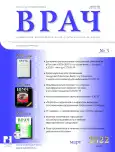«Портреты» пациентов с инфарктом миокарда, осложненным нарушениями проводимости сердца
- Авторы: Брюханова И.А1, Горбунова Е.В1, Мамчур С.Е1, Барбараш О.Л1
-
Учреждения:
- Научно-исследовательский институт комплексных проблем сердечно-сосудистых заболеваний
- Выпуск: Том 33, № 3 (2022)
- Страницы: 50-55
- Раздел: Статьи
- URL: https://journals.eco-vector.com/0236-3054/article/view/114605
- DOI: https://doi.org/10.29296/25877305-2022-03-10
- ID: 114605
Цитировать
Полный текст
Аннотация
Цель исследования - провести сравнительный анализ клинико-анамнестических данных пациентов с инфарктом миокарда (ИМ), осложненным блокадами сердца, при отсутствии показаний для постоянной электрокардиостимуляции и наличии показаний для имплантации водителя ритма в остром и отсроченном периодах после индексного события. Материал и методы Сформирована когорта пациентов с перенесенным ИМ (2011-2015), осложненным нарушениями проводимости сердца. В 1-ю группу (n=72) вошли пациенты, которым не был имплантирован электрокардиостимулятор (ЭКС); во 2-ю (n=46) и 3-ю (n=68) группы включили пациентов с ИМ, имеющих показания для ранней и отсроченной имплантации водителя ритма. Результаты. В 1-й группе преобладали пациенты с нижним ИМ с подъемом сегмента ST (ИМпБT), атриовентрикулярной (АВ) блокадой II степени, однососудистым поражением коронарного русла и успешным проведением чрескожного коронарного вмешательства. Во 2-ю группу вошли больные с передним ИМ без подъема сегмента ST (ИМбпБT), осложненным сердечной недостаточностью II-IV степени по классификации Killip, имеющие многососудистое поражение коронарных артерий, преимущественно с АВ-блокадой III степени. В 3-й группе в равном соотношении регистрировался ИМпST и ИМбпST нижней локализации, осложненный АВ-блокадой II степени, корригированной постоянной ЭКС через 3,2±1,9 года после острого коронарного события. Заключение. Выявленные различия клинико-анамнестических данных у пациентов с ИМ, осложненным блокадами сердца, свидетельствует о целесообразности разработки алгоритма, определяющего тактику ведения пациентов с нарушением проводимости сердца при остром ИМ.
Полный текст
Об авторах
И. А Брюханова
Научно-исследовательский институт комплексных проблем сердечно-сосудистых заболеваний
Email: e.v.gorbunova@yandex.ru
Кемерово
Е. В Горбунова
Научно-исследовательский институт комплексных проблем сердечно-сосудистых заболеваний
Email: e.v.gorbunova@yandex.ru
доктор медицинских наук Кемерово
С. Е Мамчур
Научно-исследовательский институт комплексных проблем сердечно-сосудистых заболеваний
Email: e.v.gorbunova@yandex.ru
доктор медицинских наук
КемеровоО. Л Барбараш
Научно-исследовательский институт комплексных проблем сердечно-сосудистых заболеваний
Автор, ответственный за переписку.
Email: e.v.gorbunova@yandex.ru
член-корреспондент РАН, доктор медицинских наук, профессор
КемеровоСписок литературы
- Yadav S., Yadav H., Dwivedi S.K. et al. The time to reversal of complete atrioventricular block and its predictors in acute ST-segment elevation myocardial infarction. J Electrocardiol. 2020; 63: 129-33. doi: 10.1016/j.jelectrocard.2020.10.008
- Chera H.H., Mitre C.A., Nealis J. et al. Frequency of complete atrioventricular block complicating ST-elevation myocardial infarction in patients undergoing primary percutaneous coronary intervention. Cardiology. 2018; 140 (3): 146-51. doi: 10.1159/000491076
- Kosmidou I., Redfors B., McAndrew T. et al. Worsening atrioventricular conduction after hospital discharge in patients with ST-segment elevation myocardial infarction undergoing primary percutaneous coronary intervention: the HORIZONS-AMI trial. Coron Artery Dis. 2017; 28 (7): 550-6. doi: 10.1097/MCA.0000000000000525
- Искендеров Б.Г., Казанцев А.В., Ильин О.А. и др. Сроки и показания к имплантации кардиостимулятора у больных острым инфарктом миокарда, осложненным атриовентрикулярной блокадой. Кардиология. 2000; 8: 20-4.
- Искендеров Б.Г., Максимов Д.Б. Атриовентрикулярные блокады, осложнившие течение острого инфаркта миокарда: выбор оптимальных сроков и уточнение показаний к имплантации кардиостимулятора. Известия высших учебных заведений. Поволжский регион. Медицинские науки. 2011; 2 (18): 82-9.
- Острый коронарный синдром без подъема сегмента ST электрокардиограммы. Клинические рекомендации Министерства здравоохранения Российской Федерации. М., 2020; с. 152.
- Острый инфаркт миокарда с подъемом сегмента ST электрокардиограммы. Клинические рекомендации Министерства Здравоохранения Российской Федерации. М., 2020; с. 157.
- Мамараджапова Д.А., Мамутов Р.Ш., Уринов О. Догоспитальная и госпитальная внезапная сердечная смерть от острого инфаркта миокарда в зависимости от факторов риска. Вестник экстренной медицины. 2014; 1: 55-60.
- Бадыков М.Р., Плечев В.В., Сагитов И.Ш. и др. Анализ осложнений и особенности коронарного кровоснабжения у пациентов с синдром слабости синусового узла и имплантированным электрокардиостимулятром. Медицинский вестник Башкортостана. 2018; 13 (3): 11-6.
- Клинические рекомендации по применению электрокардиостимуляторов, имплантируемых кардиовертеров-дефибрилляторов, устройств для сердечной ресинхронизирующей терапии и имплантируемых кардиомониторов. М. 2017; с. 702.
- Stewart R.A.H., Gao W., French J.K. et al. Or the Hirulog and Early Reperfusion or Occlusion (HERO-2) Trial Investigators. Prognostic differences between different types of bundle branch block during the early phase of acute myocardial infarction: insights from the Hirulog and Early Reperfusion or Occlusion (HERO)-2 trial. Eur Heart J. 2006; 27 (1): 21-8. doi: 10.1093/eurheartj/ehi622
- Клинические рекомендации Министерства Здравоохранения Российской Федерации «Брадиаритмии и нарушения проводимости». М., 2020; с. 113.
- Samii S.M. Indications for pacemakers, implantable cardioverter-defibrillator and cardiac resynchronization devices. Med Clin North Am. 2015; 99 (4): 795-804. DOI: 10.1016/j. mcna.2015.02.008
- Fan X., Maharjan P., Liu P. et al. Effect of primary PCI on the recovery of atrioventricular block in inferior STEMI patients with late presentation (>12 hours): insights from a single center 10-year experience. J Investig Med. 2020; 68 (5): 1011-4. doi: 10.1136/jim-2019-001255
- Malik J., Laique T., Farooq M.H. et al. Impact of primary percutaneous coronary intervention on complete atrioventricular block with acute inferior ST-elevation myocardial infarction. Cureus. 2020; 12 (8): e10013. doi: 10.7759/cureus.10013
Дополнительные файлы





